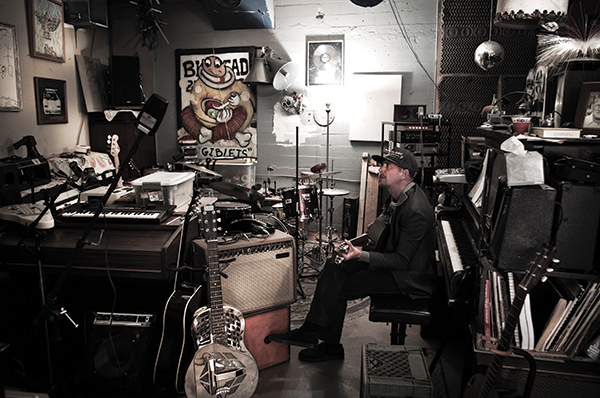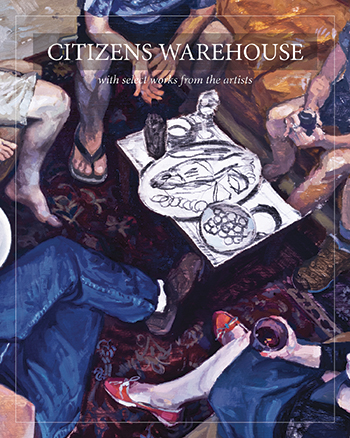Citizens Warehouse Captured in Print

Christopher Stevens. Photo by Alec Laughlin
Downtown historic warehouses teem with artists, though you likely wouldn’t guess it driving by the mostly century-old warehouses on Toole Avenue or the nearby Citizens Warehouse. Dozens and dozens of artists are hunkered away inside. Not much is happening streetside. And thus the entire artisan subculture goes largely unnoticed, other than during the pair of Open Studios Tours each year.
But the artists are there year-round, pretty much anonymously. Alec Laughlin counts among that number. He’s had a studio at the Citizens Warehouse since only January 2011. Before then, the acrylic and charcoal painter was truly anonymous, working out of his home.
In just a bit over two years encamped in the Historic Arts District, Laughlin has taken on the duties of president of the Warehouse Arts Management Organization (WAMO) and published “Citizens Warehouse,” a 140-page tome densely packed with select works by 24 artists that call the Citizens Warehouse their artistic home.
“The book is my big neon sign and marquee for the building,” Laughlin said. “I just want to shine a spotlight on the Citizens Warehouse and the artists that work inside. I just realized so much was going on in there with so much creative energy, but nobody knew it. When you drive by, this building is just a huge hulk that looks empty. I just realized the artists needed exposure.”
You can meet all the artists on May 9 from 6 to 9 p.m. at the book launch party at the Citizens Warehouse, 44 W. 6th St. Laughlin stresses there are “huge parking lots north and east” of the warehouse. Online promotional material, and Laughlin in conversation, make it a point to stress that the book launch party involves “beer and wine.”
“It’s mostly come and meet the artists. It’s a party in my studio. If you ask, artists might show you their studios,” Laughlin said. Laughlin scheduled the party for a Thursday evening. “I didn’t want to compete with other events or people going out to dinner.”
People who pre-ordered “Citizens Warehouse” can pick up the book at the party. The $40 book will also be for sale there. Otherwise, the book may be purchased online at citizensart.com, the Web site for the Citizens Artist Collective, which the warehouse artists established in 2010 to “manage the affairs and concerns of the artists in their relation to Citizens Warehouse management.”
The Collective and Lauglin’s work on the book has altered the dynamic within the Citizens Warehouse. “The artists are interacting with each other more,” Laughlin observed. “That’s a big difference. It’s so nice to have this artistic camaraderie.” The book devotes four pages to each artist with five, six or seven artistic images and bio material. Julie Sasse, chief curator at the Tucson Museum of Art, wrote the forward. As much as the book is about the artists, the book does not ignore the building’s history.
The Citizens Warehouse has stood at 6th Street and Stone Avenue since 1929, first as a one-story structure, and then a second story was added in 1951. Architect Roy Place designed the warehouse with cast-in-place reinforced concrete that can support a five-story structure, something that has not yet happened. With taller buildings now rising around Downtown, who knows whether Place’s over-engineering will produce more levels. If the name Roy Place sounds familiar, he also was the architect of the iconic Pima County Courthouse and the historic Montgomery Ward building that now houses the University of Arizona Downtown. These buildings and the warehouse all became downtown fixtures in the same year: 1929. The warehouse was built for the Citizens Transfer & Storage Co., which was established in 1907 to deliver goods and merchandise from the railroad to merchants and individual. For the first two decades, Citizens operated on Congress Street before building the warehouse.
The Arizona Department of Transportation bought the Citizens Warehouse in 1984 along with 36 more warehouses and other properties with the intention to demolish them all to build a bypass road to link the Barraza-Aviation Parkway to Interstate 10. Most of the warehouses where spared as the City of Tucson took on the bypass and realigned the route to preserve warehouses that had spawned an arts district in the 1980s.

Citizens Warehouse Book cover
Artists have leased space inside the state-owned Citizens since 1994, sparked by arts space manager David Aguirre fielding requests for studio space and him observing a vacant Citizens Warehouse. The Warehouse Arts Management Organization is the warehouse’s master lease holder. “The building is safe. What’s tenuous about it is, when the state plans to unload it, it would go up for auction,” Laughlin said. Artists have one primary objective: “Whatever needs to be done to preserve the building as artists’ studios and affordable space.”
Lease or own is a question floating around. Like with a home, leasing and owning each have their own advantages and drawbacks. Laughlin envisions the Collective, BICAS (a Citizens Warehouse tenant) and WAMO could own Citizens collectively. Or the City or some other entity could own it and the artist continue leasing.
“We do talk about it, the challenge you’d face,” Laughlin said. “We’d like to see ownership by an arts organization.”
The first run of “Citizens Warehouse” produced 500 copies with another 200 or 300 available. All the proceeds from the book will go to the Citizens Artist Collective for repairs and maintenance to the building and public programs. “We need a new roof. It leaks really badly,” Laughlin said. “We want to try to engage with the community more with classes and field trips. We want to set up some scholarships.”
The Collective recently became a nonprofit and Laughlin established Eponymous Atelier as the publishing entity for the book and possible future books. The book was made possible in part through an initiative of the Tucson Pima Arts Council, in partnership with the Warehouse Arts Management Organization, and sponsored by a National Endowment for the Arts Our Town grant. To learn more about the initiative, visit www.tucsonpimaartscouncil.org.
Category: Arts, Community, DOWNTOWN / UNIVERSITY / 4TH AVE




